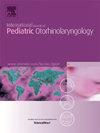The role of childhood diphtheria in the popularization of the tracheostomy
IF 1.2
4区 医学
Q3 OTORHINOLARYNGOLOGY
International journal of pediatric otorhinolaryngology
Pub Date : 2025-03-13
DOI:10.1016/j.ijporl.2025.112313
引用次数: 0
Abstract
Introduction
In the mid-nineteenth century, with the world in the grip of repeated diphtheria epidemics, tracheostomy evolved as a potentially lifesaving tool for pediatric patients. Though intubation and antitoxin eventually made the procedure all but unnecessary in diphtheria, this period spurred discussion of technique, complications, and aftercare that advanced the field of airway surgery. Growing acceptance for tracheostomy allowed twentieth-century physicians to adapt the procedure to chronic respiratory failure and pulmonary toilet and paved the way for it to become one of the most common airway surgeries performed today.
Methods
We performed a literature review with an emphasis on the use of primary sources with the objective of describing the development of tracheostomy during the mid-nineteenth to twentieth century.
Results
Tracheostomy has been used in the treatment of upper airway obstruction from foreign body since the second and third centuries B.C.E. In the nineteenth century, obstruction from pharyngeal pseudomembrane related to Corynebacterium diphtheriae infection became commonplace and associated with significant risk of mortality. Pierre Fidele Bretonneau and his pupil Armand Trousseau were the first to perform tracheostomy in cases of diphtheria. By 1887, over 20,000 tracheostomies had been performed in the treatment of diphtheria in Europe and America. Disagreements abounded over preferred timing, the role of anesthesia, placement technique, and post-operative care, with widespread discussion in the medical literature. Though intubation and diphtheria antitoxin ultimately replaced tracheostomy in the treatment of these patients, the use of tracheostomy in the management of upper airway obstruction from other etiologies increased after this period.
Discussion
The use of tracheostomy in pediatric patients with diphtheria was instrumental in standardizing the procedure, identifying its complications and their management, and promoting public acceptance of the practice as a treatment for upper airway obstruction. Today, although most of us will never see a case of diphtheria, we continue to face patients in what Scottish surgeon James Spence called “the agonies of suffocation.” That we have the tools to manage complex airway obstruction comes in part from the heroic efforts of the physicians of the nineteenth century who, despite heartbreaking losses, advanced the technique of tracheostomy in their fight against childhood diphtheria.
求助全文
约1分钟内获得全文
求助全文
来源期刊
CiteScore
3.20
自引率
6.70%
发文量
276
审稿时长
62 days
期刊介绍:
The purpose of the International Journal of Pediatric Otorhinolaryngology is to concentrate and disseminate information concerning prevention, cure and care of otorhinolaryngological disorders in infants and children due to developmental, degenerative, infectious, neoplastic, traumatic, social, psychiatric and economic causes. The Journal provides a medium for clinical and basic contributions in all of the areas of pediatric otorhinolaryngology. This includes medical and surgical otology, bronchoesophagology, laryngology, rhinology, diseases of the head and neck, and disorders of communication, including voice, speech and language disorders.

 求助内容:
求助内容: 应助结果提醒方式:
应助结果提醒方式:


